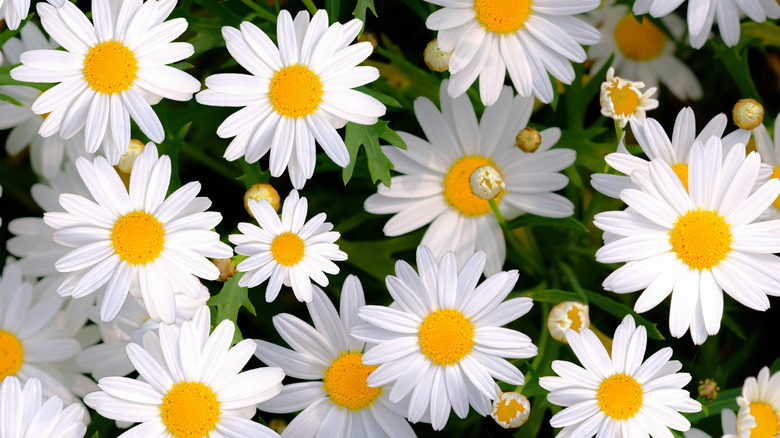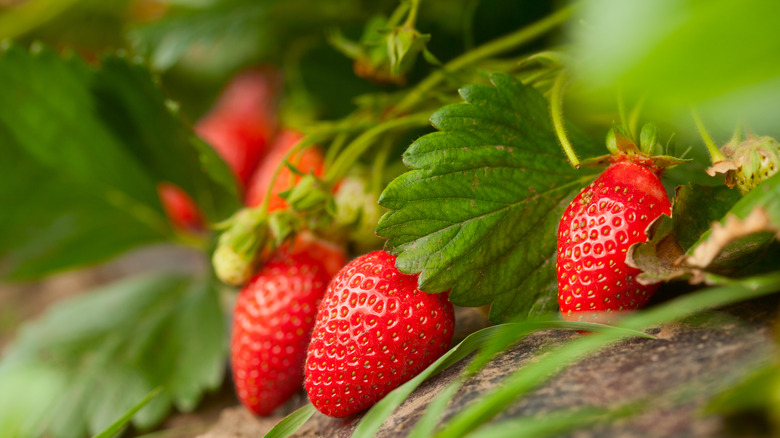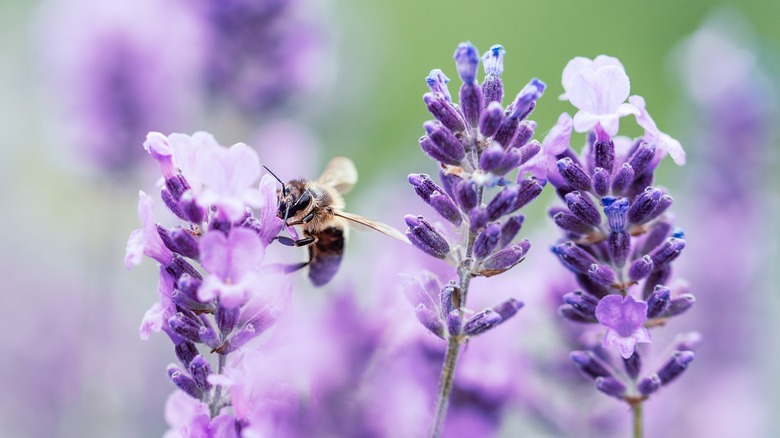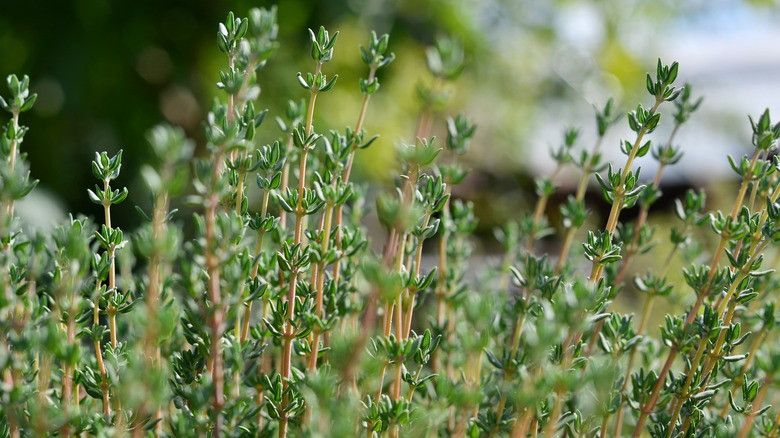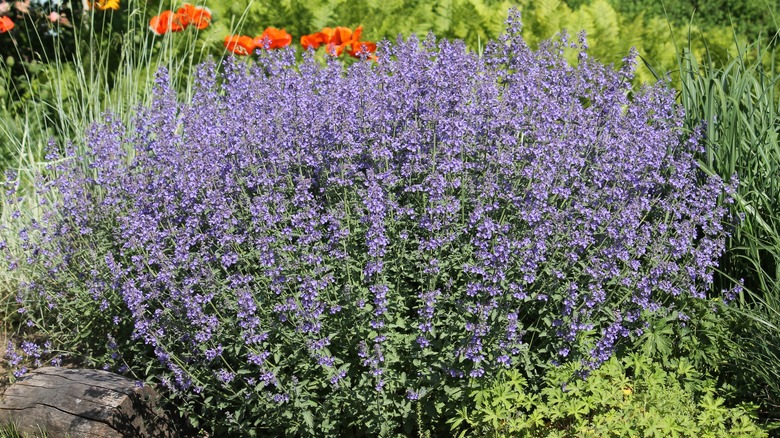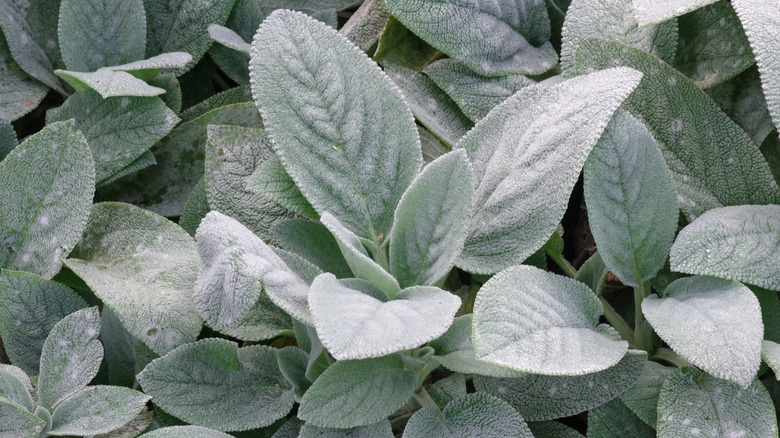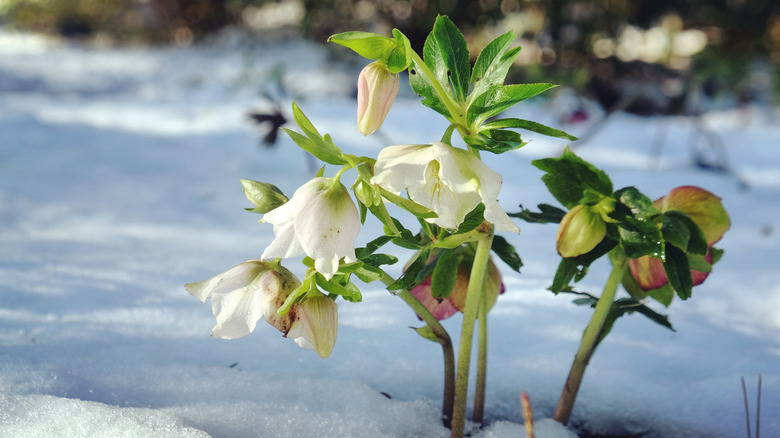Plant These Perennials In Your Garden Once And They'll Never Leave
If you have ever wanted a low-maintenance garden, you might want to consider planting perennials. Plants come in two different types: perennials and annuals. As their name suggests, annuals are those plants that have one long growing season every year before dying off in the winter and needing to be replanted in the spring. Think vegetable gardens, cosmos, zinnias, and marigolds. More often than not, annuals require planning and labor in order to thrive. Perennials are the opposite.
By their very nature, perennials return year after year in the spring after a winter hibernation. They only need to be planted once, making for excellent, low maintenance additions to any garden. Perennials also provide scenic, culinary, and potential medicinal value. The question is: what to plant?
There are literally thousands of different varieties of perennial plants to choose from. The 20 we're listing are just the tip of the iceberg. We've sprinkled in some time-honored classics, as well as some plants you might not actually know are perennials. Our hope is that you end up choosing some to plant, because, more than anything else, these perennials are just gorgeous to look at.
Foxglove
The common foxglove is an ornamental perennial that has a very unique shape. Characterized by its bell-shaped blooms, this common perennial flower comes in multiple different colors, and would make a beautiful addition to any flower bed. Their tall stems and drooping blossoms make foxgloves look almost like small, brightly-colored trees. Closer examination shows a long, spiky stem with wide green leaves, and between 20 to 80 flowers per plant.
Though they will return on a yearly basis, the lifespan of foxglove is rather short. They tend to bloom and die in early summer to attract pollinators like honey bees, hummingbirds, and butterflies. A foxglove can produce several million seeds in a single bloom, which can be carried by the pollinators to other gardens and wild spaces.
As for planting, it takes at least one to two years for a foxglove to be mature enough to bloom. Plant them in a sunny area in well-aerated soil amended with plenty of nutrients. They will work well alongside several of the other perennials on this list, such as roses, peonies, and black-eyed Susans. Foxglove adds a great dimension of color to your garden, and will continue to bloom in early summer for many years to come.
Shasta daisy
If you are looking for one of the more low-maintenance perennials on this list, the Shasta daisy is a great choice. These little rays of sunshine are incredibly hardy and grow in large bushes year after year. Often considered to be the most perfectly-shaped and colored of all daisies, the Shasta is defined by its numerous, thin, white petals that border a bright yellow central disk.
First cultivated in 1901 as a hybrid cross between the oxeye, English, and Portuguese field daisies, the Shasta lives up to its potential as a hardy perennial. It can be planted in hardiness zones 5 through 9, meaning that it can tolerate both the chill of winter and the heat of summer. They do like full-sun areas, however, so be sure to plant them in the spot in your yard that sees the most sun.
Shasta daisies will grow in bushes that can grow up to 5 feet wide. They attract numerous pollinators, making them healthy for the garden, but they also ward off some of the more common garden pests. They repel several insects and the plant diseases they can carry, as well as revolt deer and rabbits, both of which can wreak havoc on a garden. Shasta daisies are also fairly drought resistant, so if your town has an ordinance against plant watering, the daisies should have no problem surviving.
Black-eyed Susan
Almost the exact opposite of the Shasta daisy in terms of coloration, black-eyed Susans remain one of the prettiest, and most prolific, perennial flowers you can plant in your garden. These are tall flowers with relatively clumped bloom that form a sunshine-yellow ring around the small black disk, or eye. Susans flower late in the summer and last well into the fall, giving them a longer life than some perennial flowers, and keeping your garden beautiful for longer.
A member of the aster family, black-eyed Susans are a common sight throughout the northeastern United States, and can grow in hardiness zones 3 through 9. This means that they are more cold hardy than the Shasta daisy, which is likely why the Susans' bloom can last well into the fall. The stems can grow upwards of 3 feet tall, giving these flowers a look like they are reaching towards the sun. The blooms attract a host of bees and other pollinators, and work well in border gardens, or even in container pots on the porch.
These flowers will certainly bring brightness anywhere they are planted. Just make sure that you read the seed packet before purchasing and planting. There are some varieties of this plant that are sold as biennials or annuals, and won't keep for nearly as long.
Echinacea
You're likely more familiar with this perennial for its medicinal qualities and use in tea and cough drops. We'll get to that in a little bit, because what's more important is the fact that you can grow this flower in your garden with relative ease. Also known as coneflowers, echinacea are wonderfully colorful flowers that are sure to make you and your visitors smile. Coming in a variety of different shades, such as pink, purple, orange, and an assortment of mottles, echinacea are hardy little blooms that require next to no water, but lots of sun, in order to thrive.
The cone of the echinacea plant is a raised disk emerging out of the middle of the flower. The surrounding petals blossom outwards like a fan. As a member of the daisy family, these flowers can be planted once, and resow themselves in the same spot year after year. They are also very cold and heat tolerant, with a hardiness range from zones 3 to 9.
As for medicine, echinacea can be used as a dietary supplement to combat common cold and flu symptoms. The plants can also be used to make a salve that can be applied to cuts and skin irritation. However, most gardeners are going to plant it for its pollination and scenic value as opposed to growing it specifically for medicinal purposes.
Strawberries
Though you might tend to think of perennials only in terms of flowers and leafy plants, there are plenty of fruits that you can grow as perennials. Apple, peach, and cherry trees bloom and fruit year after year, but they require several years of growing to take hold and need cultivated orchard spaces in order to thrive. Strawberries, however, can be planted once and thrive immediately, and in the years following.
Though more commonly planted as an annual, owing to their tendency to spread out of control, strawberries can work as a perennial. If you can keep them properly pruned and mulched, the strawberries will resist rot and disease. Though they can be direct sown, perennial strawberries work best as container plants. Strawberries will go dormant during the winter, and can withstand temperatures as low as 10 degrees Fahrenheit, provided they have been properly mulched. While it does take a lot of work for strawberries to work as a perennial, the results are always worth the effort.
Strawberries are perhaps one of the most beloved fruits of all time. Their blisteringly red color and sweet, juicy flesh makes them ideal for summertime desserts and eating. They do tend to thrive in the sun, but don't mind a little shade now and again.
Blueberries
Partnering with strawberries as perhaps the second most popular summertime fruit, blueberries are much more manageable as a perennial than their red counterparts. This is because while strawberries grow as spreading vines, blueberries grow in bushes. While it may take them several years worth of growing to reach their full fruiting potential, once blueberries are established in your garden, they are there to stay.
Blueberries that are well taken care of and cultivated will last for upwards of 50 years. They will produce fruit in the summer, which can be picked and enjoyed throughout the season. Rich in antioxidants and brimming with wonderful fresh flavor, the blueberries that return year after year are going to provide you with an abundance of berries.
Seeing as wild blueberries thrive in some of the harshest places, having them in your garden is going to be like a cake walk in terms of care. While they prefer acidic soil, you can amend your garden soil accordingly to make things work. Blueberries will thrive in numerous different hardiness zones, and their leaves will turn a vibrant rust color in the fall. Bushes can grow up to 5 feet wide, so be sure to space them accordingly.
Lavender
Another perennial that has culinary and medicinal uses, lavender is a great flowering herb to plant once and have done with it. Lavender grows in long, skinny chutes that bud with small purple flowers at the top. Known for its sweet and distinctive scent, lavender can be used to bring a little color to your herb garden. It can be directly sown into the ground, or grown in containers. Lavender can be used to make scent sachets, bath bombs, teas, soaps, and salves. The calming properties of the herb have also been known to aid in sleep.
Now, there are several different varieties of lavender, which make it an excellent option to grow in a variety of different hardiness zones. While some can be more hardy than others, the general rule is that lavender grows well in zones 5 through 9, meaning that it can generally withstand some cold and heat. Mediterranean varieties, like Spanish lavender, really work better in warmer zones owing to their place of origin.
Lavender will grow several inches or feet in height. It all depends, again, on the variety and how you plant it. A great attractor of pollinators, lavender will reseed itself in the fall and winter for an extended bloom in the summertime. Walking up a garden path lined with lavender is as luxurious an experience as any.
Iris
If the shasta daisy is a low-maintenance perennial, the iris has to be the easiest to grow from start to finish. There is nothing short of an apocalyptic event that will prevent irises from flowering. Because there are over 300 varieties of irises available to plant, they can handle a whole mix of different soils and hardiness conditions. They will bloom early in the spring, even when there is still snow on the ground, and last throughout the summer. Plant your irises in the fall so they have the opportunity to overwinter and establish their root system for an early spring bloom. Much like garlic and other tuber plants, irises will survive a winter in the ground.
Once they've bloomed, you'll see why they are such a popular perennial to plant. They have large, drooping petals that come in a variety of different, mottled colors. And because they are rhizomes, they will easily spread throughout a garden bed and take over an area completely if not kept at bay.
Depending on the variety you plant, an iris can grow up to 4 feet tall and bloom different sized flowers. All irises are relatively resistant to rot and will repeatedly bloom year after year.
Peony
An elegant and popular flower, peonies are a must in any ornamental flower bed or cut flower garden. Though often confused for roses thanks to their layered blooms, peonies are one of those perennial plants that refuse to quit year after year. This is exactly what you want in a perennial, and the peony delivers time and time again. They will grow, bud, and flower in the exact same spot without fail.
Peonies are distinguished by their fat, layered blooms. Though they originally only came in three primary colors: white, crimson, and pink, there are now a wide variety of different colors available including yellow, purple, and orange. Like other perennial flowers, peonies are easy to plant and begin to bloom in the early spring. Their flower blossoms come in several different forms, including shapes like anemone, single, double, and double bomb. Peonies require fat, green stems to keep the large blooms from drooping to the ground.
These incredibly hardy plants can survive in zones 2 through 8, meaning that they can tolerate some pretty extreme winter temperatures and still burst back stronger than ever. You need to realize something when you plant a peony. Their life span can stretch well over a century. So you are very likely going to be offering a generational flowering from a single plant. Isn't that amazing?
Roses
Another beautiful flower that you can plant once and care for for years to come, roses are, perhaps, the most popular and recognized flower in the entire world. Though certain roses might be fussy and require extra care if you want to get the best out of them, the vast majority of roses, once planted, will continue to flower for years on end. This could be for a long time. There is a rosebush in Germany that is reported to be well in excess of 1,000 years old. Think about the history those flowers have seen.
There is no shortage of roses that you can plant in your garden. You will need to check on the hardiness of the flowers, because some are more winter hardy or heat resistant than others. Ideally, roses grow best in zones 5 to 8, which is a pretty wide range, but by no means extreme.
Roses bloom in beautiful, colorful layers in the late spring or early summer, and don't last very long afterwards. Have them as ornamental plants to add color and elegance to your garden, or use them as cut flowers to match with peonies, irises, and hydrangea. Roses come in a kaleidoscope of colors, ranging from the most vibrant of reds, to the most subtle of orange and pinks. They make a great addition to any garden.
Hydrangea
If you've ever been to Cape Cod in Massachusetts, you've no doubt seen the absolute proliferation of hydrangeas on the peninsula. Lovers of sandy soil and moist summer climates, hydrangeas are part of the reason the Cape Cod architectural style and adjoining garden are famous. The flowers of a hydrangea are nothing short of iconic. Bulbous and huge, the flower heads of this shrub plant can sometimes come in multiple different colors, like blue, white, purple, and pink, on the same plant. Hydrangeas that have been planted in the spring and well cared for can live upwards of 50 years.
Though they do love the soil of Cape Cod, hydrangeas are incredibly versatile and work well with all soil types and in a variety of different climates. Their hardiness zones are 3 through 9, meaning that they will winter well and thrive in the summer. They prefer partial sun, making them great ornamental pieces to plant alongside houses, or on the corners of your shade garden.
The enormous flowering blooms will last from summer and well into fall, giving you a full season's worth of their colorful beauty. Paired alongside peonies and roses, hydrangeas make for another beautiful and iconic perennial to plant in your garden.
Thyme
There is no shortage of perennial herbs that can be planted and enjoyed for their culinary value year after year. Thyme, however, has to be one of the most fragrant and hardy of all the herbs. It takes little to no maintenance to get thyme to thrive, even in a container garden. Being of Mediterranean descent, certain varieties of thyme do prefer warmer climates to colder ones, but with the right care, these are perfect for container gardening in colder areas.
Thyme plants have long, thin stalks and small, roundish leaves that grow in closely knit bunches around the stalk. They have a wonderful fragrance that can be scented from several feet away, and have amazing applications in the kitchen.
This is one perennial herb you will really want to have in your kitchen garden. Thyme can be used in a number of different things, like soups, salad dressings, sauces, and as a seasoning for meats like chicken, beef, pork, and fish. There's no shortage of what you can do with this herbaceous perennial. So keep some on hand and ready to go the next time you're cooking.
Catmint
From a distance, this catmint can often be confused for lavender. They have the same basic construction, long stems with tight, flowering buds at the top. However, unlike lavender, which has a light purple color, catmint is defined by its blue flowers emerging from the ground level shrubs of classic green mint leaves. Catmint is great for partnering with a number of other perennials that enjoy lots of sun and partial shade, like peonies, hydrangea, and roses.
A member of the mint family, catmint can be used in both cooking and in medicine. It does not have nearly as strong a flavor as some other varieties of mint, but it will work just as well as an addition to a cocktail, summer lemonade, tea, or salad. The good news is, too, that it is virtually indestructible.
Catmint can thrive in hardiness zones 3 through 9. On the hotter end of the spectrum, catmint really thrives because it is both resistant to heat and tolerant to drought. The mint will bloom in the spring, summer, and fall if you take some time to shear back the plant and allow it to re-grow. It's a great little tuft of blue that will work very well in both ornamental, and kitchen gardens.
Lamb's Ear
If you have soil that is more dry and on the acidic side, Lamb's ear is actually going to be a fantastic choice for you in this regard. Known primarily for its soft, tufty, silver leaves, lamb's ear will spread easily across the garden and form something of an ornamental bed of fuzzy leaves. Their flowers will bloom in the late spring, which grow upwards from the center of the plant in tall, purplish cones.
One of the reasons that lamb's ear does so well in poorer soil is because of its native origins in the Middle East. As much of this area is arid and rocky, lamb's ear can easily thrive in a hardiness zone up to 9 and be well suited for status as greenery in a rock garden. Therefore, they are very tolerant of heat and only require less than an inch of moisture a week to thrive, which can easily be collected in temperature changes between night and morning.
If you live in a cooler climate, lamb's ear will require a spot in full sun in order to get the light that it needs to thrive. In warmer climates, keep it in partial sun and shade to be on the safe side. The plant will propagate itself enough to consume any plants that have rotted or gone to seed. Therefore, weeding should not be too much of a problem, as the dead plants can just be consumed back into the earth.
Aster
Though they are often mistaken for daisies, asters are a beautiful breed of perennial all their own. Though most perennials bloom in the spring and summer, asters actually begin showing their color in the fall. They represent the final swan song of the season before the colds of winter kick in and make everything dormant. Speaking of winter, asters are incredibly cold hardy, and are prominently featured in perennial gardens throughout the northeast. New England and New York asters are among the most popular of the over 600 varieties.
Like daisies, asters are composed of several, small, long flower petals rung around a central yellow disk. The plants can grow up to 6 feet tall, and the blooming flowers create beautifully colorful patterns in shades of purple. Asters prefer moist, well aerated soil, and thrive in partial sun in colder climates. If you live in warmer areas, make sure asters don't get the hot midday sun, as it could cause them to dry up and die.
Asters make a great addition to any perennial flower bed or rock garden. They are also excellent for late season pollinators like monarch butterflies, and their seeds make great food for birds like nuthatches and chickadees. And don't worry about the first frosts of fall killing off your asters. They have been known to survive frosts and continue blooming.
Bee balm
As its name suggests, this plant makes excellent fodder for bees. Also known as wild bergamot, bee balm likes to bloom late in the summer, presenting colorful bursts like fireworks. Though these plants are relatively easy to grow, they do prefer lots of water and rather acidic soil in order to live up to their full potential. Bee balms like lots of sun, but it is far from delicate. This plant will withstand temperatures in hardiness zones 4 through 9.
If you're one for giving the most possible food to pollinators, then bee balm needs to be on your list of perennials to plant. It is an absolute favorite of bees, hummingbirds, and butterflies. The more pollinators you attract to the bee balm, the more the plant will spread and continue to thrive and attract more pollinators as the years go by.
Bee balm is also another one of those perennials that can have some culinary purposes. If you crush the flowers, they release a scent that has a very spicy fragrance and flavor, making it great for herbal teas.
Daylily
We want to provide a note of caution with this perennial, only because of the fact that once they are planted, they will spread like wildfire if you have the audacity to blink. This proclivity to spread is because of the fact that, beneath the surface in the soil, the rhizomes of the day lilies spread out horizontally, creating more tubers during the winter that pop up during the spring and last throughout the summertime.
Even though some planters might consider daylilies to be invasive, with the right amount of care they can be maintained. Therefore, you'll need to reserve a specific space for them in your yard, as they, again, will spread if not maintained. This makes them a great option for container gardening if you don't want to have to handle them in the ground.
Daylillies will grow in almost any soil, so long as there is plenty of sun to provide them with food. They are also pretty drought tolerant and insect resistant, meaning they won't succumb to the rot or diseases that affect other plants.
Hellebore
Winter can be one of the toughest seasons for people because of the fact that nothing is growing and there is very little in the way of light and color. This is why the blooming of the hellebore, also known as the Lenten rose, is so important. This flower gets its nickname because of the fact that it blooms very early in the year, oftentimes before the snow and cold temperatures have lifted. The vibrant colors of the hellebore blossom shine through the drab of winter. The petals open and flower in a range of colors from pinks and whites, to spotted purples and light oranges.
As hellebores bloom downwards, gardeners often like to plant them on hillsides or in raised beds to take advantage of the slope in order to see the blooms. These thrive in zones 4 through 9 and will continue to blossom well into the spring. They are a wonderful sight for anyone suffering from the wintertime blues.
Once a hellebore is planted, there is very little you need to do in the way of maintenance. They need water from time to time, and thrive in well drained soil. Much like Shasta daisies, hellebores are great plants to use as borders to prevent deer from entering your garden space.
Hosta
If you have a shady area of your yard that looks bare and sad, you might want to consider planting some hostas there. Hostas are distinguished by their enormous leaves that spread out to diameters of nearly 2 feet or more if allowed to grow that large. These are one of those rare plants that thrive in complete shade. They will work in partial sun, but they love the coolness of shade as a way of continuing to thrive with very little maintenance.
Though they are primarily known for their leaves, the hosta plant will flower in the spring and summer, in petals of blue, purple, pink, and white. Hostas are also very sturdy plants, ones that don't mind being dug up, transplanted, and even dividend into separate plants. Once they have been replanted in the ground, they will thrive once again and can potentially be in excess of 4 feet tall if you let them go.
As a result of this sturdiness, they do well in numerous different hardiness zones. So long as there is an abundance of shade for them to work off of, they will do just fine.
Lupine
Finally, we have lupines. Also known as blue bonnets, these flowers are famous for their long, conical shapes, and numerous vibrant colors. Like foxgloves, the flowers on lupine stems are bell shaped and face downwards. However, unlike foxgloves, lupines can grow to insanely large sizes, and fill whole fields with their colorful stems. They can be orange, purple, blue, white, red, pink, and so many more.
Lupines are one of those perennials that can be grown practically anywhere. From the coast of Maine to the prairies of the midwest, lupines will pop up just about anywhere their seeds are scattered. The only downside to lupines are their short lives. They blossom in the middle of summer for only a few weeks before they go to seed and vanish. Still, while they are alive, they grow in excess of 5 feet tall and can provide quite the color show.
Obviously, we would need a much longer list to go over all the perennials you could plant in your garden. However, these should be enough to get you thinking about what you like and what is going to work well in your area. So, what are you waiting for? Get planting.


